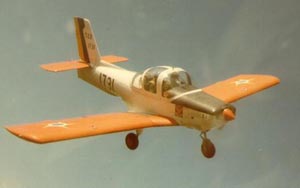Engineering:Aerotec Uirapuru
| A-122 Uirapuru | |
|---|---|

| |
| T-23A Uirapuru. | |
| Role | Primary Trainer |
| National origin | Brazil |
| Manufacturer | Aerotec |
| First flight | 2 June 1965 |
| Produced | 1968–1977 |
| Number built | 155 |
The Aerotec A-122 Uirapuru was a Brazilian military trainer aircraft. It was a low-wing monoplane with tricycle undercarriage that accommodated the pilot and instructor side-by-side. It first flew on 2 June 1965.[1]
In October 1967, the Brazilian Air Force ordered 30 aircraft to replace the obsolete Fokker S.11s and S.12s (T-21s and T-22s) that were operating in the Air Force Academy.[2] Later, they ordered another 40, and then 30 more. These were designated T-23.
The Bolivian Air Force ordered 36 examples in 1974, which flew until 1997, and in 1975 the Paraguayan Air Force bought eight aircraft to replace the Fokker T-21 (S.11). In 1986, six more were donated by the FAB. Most of them were withdrawn from service in 1992, replaced by the Enaer T-35 Pillán. As of 2009, only one T-23 is in flying conditions. Thirty others were sold in the civilian market.
A total of 155 were built including prototypes by the time production finished in 1977.[3]
The T-23 suffered fatal accidents during spin training. The problem was solved after a crash in which an instructor described his stricken aircraft's responses to his control inputs all the way to the end. Uirapurus then received a ventral fin under the rear fuselage to correct the issue.
In 1980 interest by the airforce in an improved version led to the development of the Uirapuru II.
Variants
- A-122A Uirapuru – T-23 – Military trainer
- A-122B Uirapuru – Civil version[4]
- A-122C Uirapuru – T-23C
- A-132 Uirapuru II – enlarged version with improved canopy and larger vertical tail surfaces.[4]
Operators
 Brazil
Brazil
 Bolivia
Bolivia
- Bolivian Air Force – 18 A-122A purchased in 1974.[5]
 Paraguay
Paraguay
- Paraguayan Air Force – 14 aircraft (8 in 1975 and 6 in 1986)
- Escuela Nacional de Aeronáutica Civil – 1 aircraft (early 70s)
Specifications (T-23)
Data from Jane's All The World's Aircraft 1971–72 [6]
General characteristics
- Crew: 2
- Length: 6.60 m (21 ft 8 in)
- Wingspan: 8.50 m (27 ft 11 in)
- Height: 2.70 m (8 ft 10 in)
- Wing area: 13.50 m2 (145.3 sq ft)
- Aspect ratio: 5.33:1
- Airfoil: NACA 43013
- Empty weight: 540 kg (1,190 lb)
- Max takeoff weight: 840 kg (1,852 lb)
- Fuel capacity: 140 L (37 US gal; 31 imp gal)
- Powerplant: 1 × Lycoming O-320-B2B 4-cylinder horizontally-opposed air-cooled engine, 120 kW (160 hp)
- Propellers: 2-bladed Sensenich M-76-DM-60 fixed-pitch metal propeller, 1.87 m (6 ft 2 in) diameter
Performance
- Maximum speed: 225 km/h (140 mph, 121 kn)
- Cruise speed: 185 km/h (115 mph, 100 kn) at 1,500 m (4,900 ft) (max cruise)
- Stall speed: 88 km/h (55 mph, 48 kn) (flaps down)
- Never exceed speed: 337 km/h (209 mph, 182 kn)
- Range: 800 km (500 mi, 430 nmi)
- Endurance: 4 hr
- Service ceiling: 4,500 m (14,800 ft)
- Rate of climb: 4 m/s (790 ft/min)
- Takeoff run: 200 m (660 ft)
- Landing run: 180 m (590 ft)
See also
Related development
References
- Notes
- ↑ Pereira 1977, p. 13
- ↑ Pereira 1977, pp. 13–14
- ↑ Taylor 1980, p. 10
- ↑ 4.0 4.1 Taylor 1989, p. 39
- ↑ Siegrist 1987, p. 194
- ↑ Taylor 1971, p. 10
- Bibliography
- Pereira, Roberto (July 1977). "Songbird of the Amazon". Air International 13 (1): 13–17.
- Siegrist, Martin (October 1987). "Bolivian Air Power — 70 Years On". Air International 33 (4): 170–176, 194. ISSN 0306-5634.
- Taylor, John W.R. (editor) (1971). Jane's All The World's Aircraft 1971–72. London: Sampson Low. ISBN 0-354-00094-2.
- Taylor, John W R (ed.) (1980). Jane's All The World's Aircraft 1980–81. London: Jane's Publishing. ISBN 0-7106-7105-9.
- Taylor, Michael J. H. (1989). Jane's Encyclopedia of Aviation. London: Studio Editions. pp. 39.
External links


